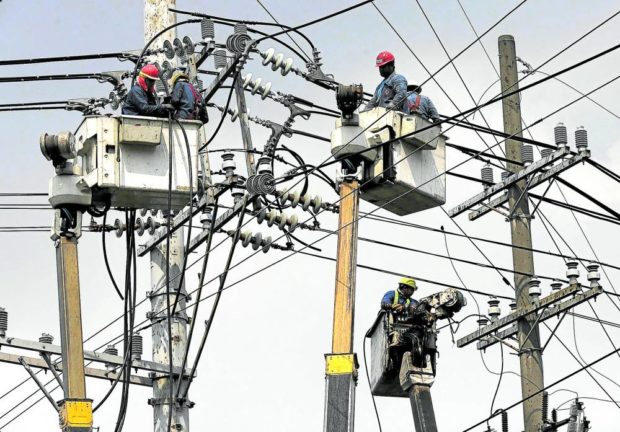
POWER RANGERS | Linemen replace the cable on electric posts along United Nations Avenue in Manila in this June 2022 photo. (INQUIRER FILE PHOTO)
MANILA, Philippines — The country’s power supply may be stable for now but electricity end-users in Luzon may encounter supply woes throughout the year — especially during the summer months—due to thin power reserves, the Department of Energy (DOE) warned.
Energy Undersecretary Rowena Cristina Guevara said while no red alerts or power interruptions are anticipated this year, yellow alerts are expected to be raised in the country’s largest island 12 times as early as March to as late as November.
In a virtual briefing, Guevara said yellow alerts are projected to be issued once in March, twice in April, the entire month of May, twice in June, one in September, one in October, and one in November.
She said these might occur during the following periods: March 12 to March 18; March 26 to April 1; April 23 to April 29; the entire month of May; June 1 to June 10; Aug. 27 to Sept. 2; Oct. 15 to Oct. 21 and Nov. 19 to Nov. 25.
Scheduled outage
The estimates made by the DOE, Guevara said, already factored in the scheduled outage of power plants with a combined capacity of 500 to 600 megawatts (MW).
But Guevara said that if at least one power plant suddenly bogged down, a red alert might be declared in the Luzon grid.
“Hopefully there won’t be any unscheduled outage because, let’s say, one power plant goes offline, red alert might be raised,” she explained.
A red alert means a supply deficiency exists, which can result in power interruptions while a yellow alert means insufficient power reserves or ancillary services.
While resolving issues hounding the supply side management, Energy Secretary Raphael Lotilla has emphasized the importance of demand side management, which he described as a “necessary element” in managing the entire power supply.
“We should not look at the demand side management as a temporary solution. This should become a natural element or embedded already in our entire management system,” he said.
Renewable plants
Running diesel-fired power plants will lower the instances of yellow alerts in the Luzon grid but Guevara said imported fuel is expensive in the global market and this might translate to higher power prices.
She also noted that this gloomy power supply scenario could have been avoided if the power projects in the pipeline are operating in full swing but the pandemic slowed down the completion of such facilities on time.
“If not for the pandemic, our renewable energy sources are online now. But upon checking with the renewable energy generators, the development of renewable energy projects really slowed down. The situation would have been okay by now. We will be able to catch up on the construction of renewable energy plants in another two years,” she explained.
Citing DOE data, Guevara said there were committed power projects with a combined capacity of 1,074 MW this year. Of these, 250 MW are coal-fired power plants, 11 MW oil power plants, 46 MW geothermal, 7.4 MW biomass, 31.36 MW hydro, 480.5 MW solar, and 110 MW wind.